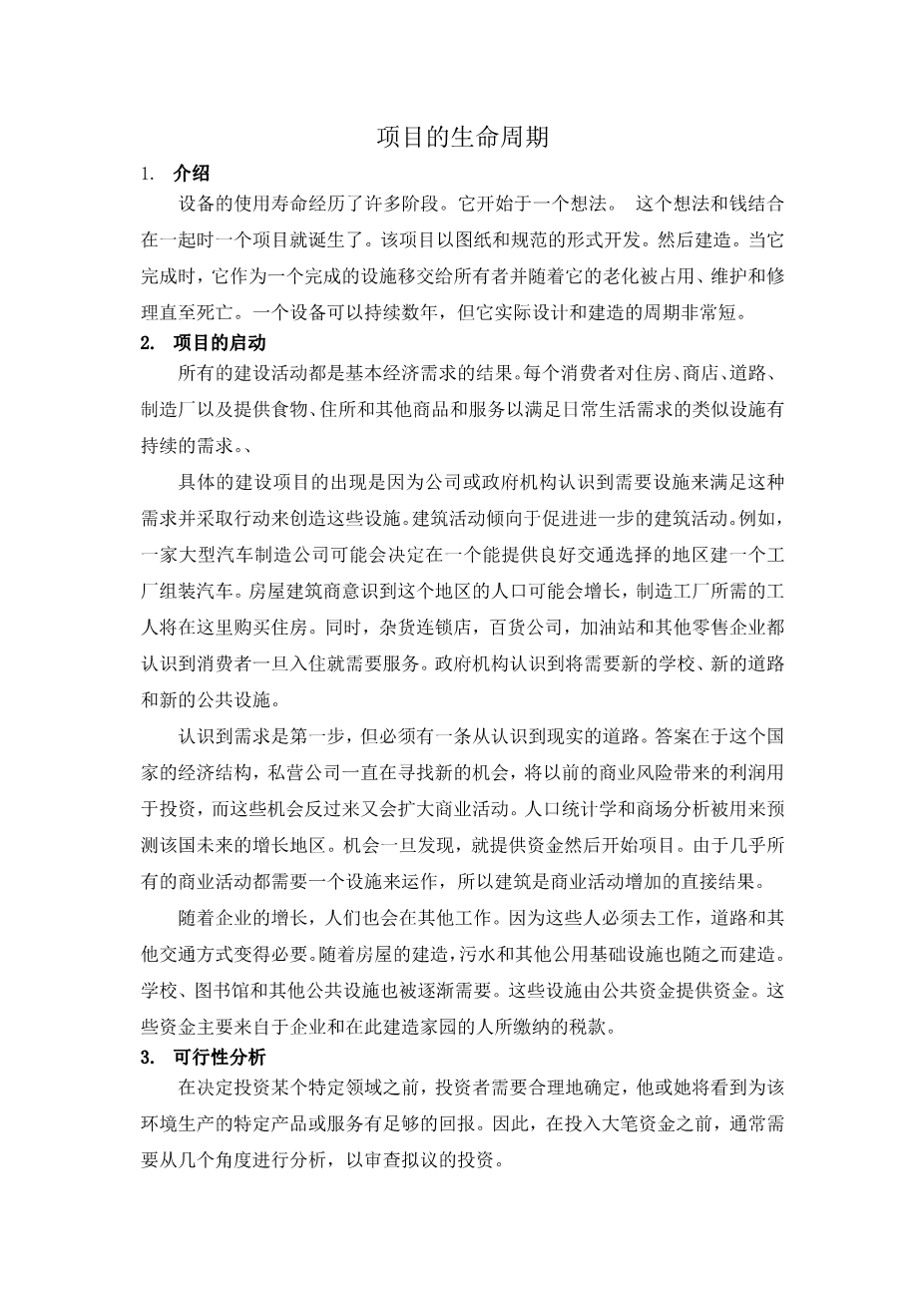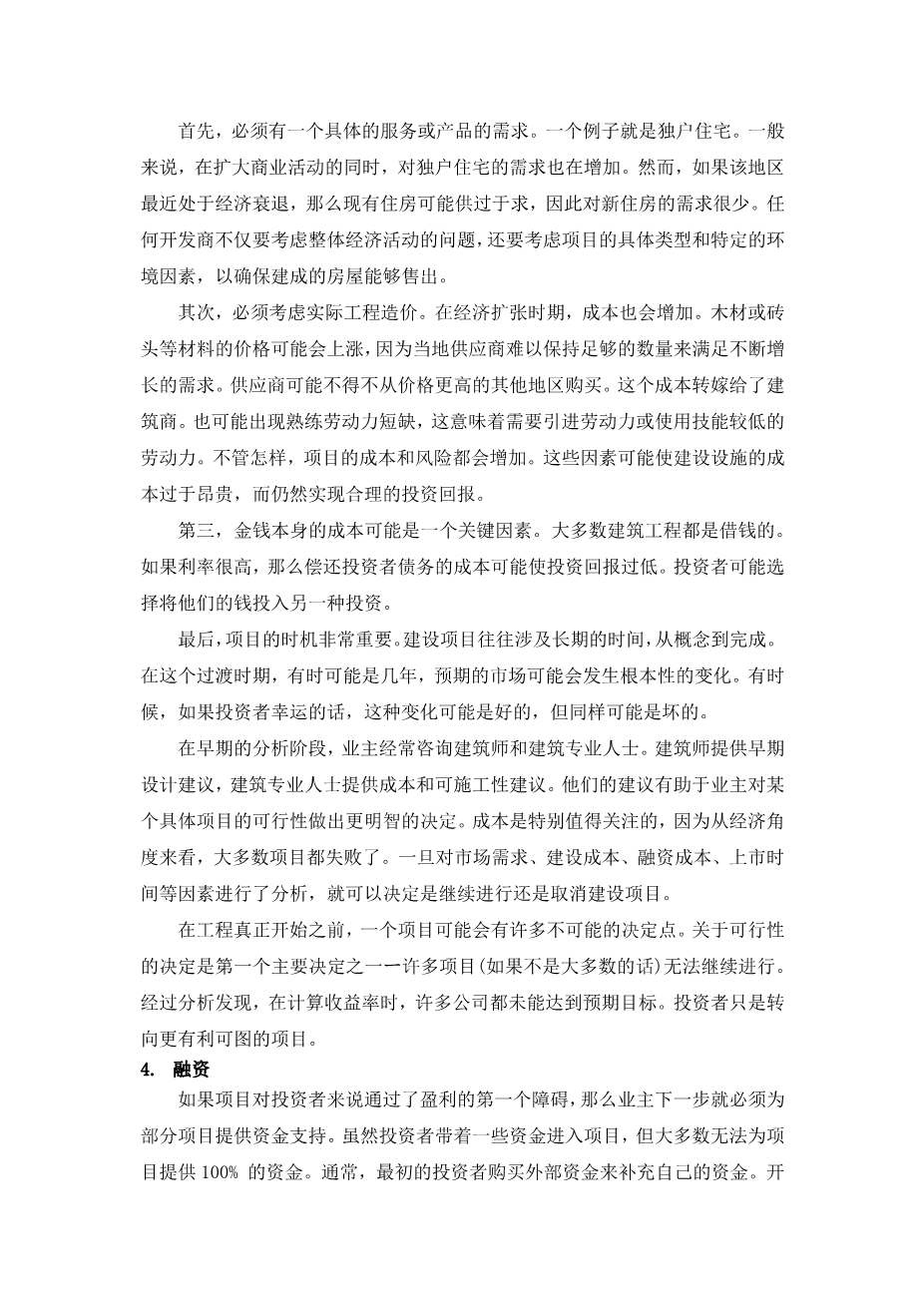项目的生命周期外文翻译资料
2023-08-17 15:24:05
Chapter outline
Project chronology
INTRODUCTION
-
- INITIATION OF THE PROJECT
FEASIBILITY ANALYSIS
-
- FINANCING
DESIGN OF THE PROJECT
5.1 Programming
5.2 Schematic Design
5.3 Design Development
5.4 Construction Document
-
- PROCUREMENT
CONSTRUCTION
-
- TURNOVER AND STARTUP
OPERATION OF THE FACILITY
-
- DISPOSAL OF THE FACILITY
CONCLUSION
- INTRODUCTION
The life of a facility goes through many phases. It starts out as an idea. The idea is combined with money, and a project is born. The project is developed as drawings and specifications. It is then built. When it is complete, it is turned over to the owner as a finished facility and is occupied, maintained, and repaired as it ages and eventually dies. A facility can last for hundreds of years, but the period in which it is actually designed and built is very small.
INITIATION OF THE PROJECT
All construction activity is the result of basic economic demand. Individual consumers have ongoing needs for homes, stores, roads, manufacturing plants, and similar facilities that provide food, shelter, and other goods and services to meet the needs of daily life.
Specific construction projects arise because corporations or government bodies
recognize the need for facilities to serve this demand and act to create them. Construction activity tends to foster further construction activity. For example, a large automobile manufacturing corporation may decide to build a facility assemble cars in a region that will provide good transportation options. Home builders recognize that this region is likely to grow in population and that the workers needed for the manufacturing plant will be shopping for shelter here. At the same time, grocery chains, department stores, gas stations, and other retail businesses recognize that consumers will need services once they move in. Government agencies recognize that there will be a need for new schools, new roads, and new utilities.
Recognizing needs is the first step, but there must be a way to move from recognition to reality. The answer lies in the economic structure of the country. Private corporations are constantly searching for new opportunities to invest profits from previous business ventures—opportunities that in turn result in expansion of business activity. Demographic and market analyses are used to forecast future growth areas in the country. Opportunities, once identified, are financed and then projects initiated. Since almost all business activity needs a facility from which to operate, construction is a direct result of the increased business activity.
As businesses increase, populations grow to work in them. Because these people must travel to work, roads and other transportation modes become necessary. As houses are built, sewage, water, and other utility infrastructure accompany them. Schools, libraries, and other public facilities are also needed. These facilities are funded with public money that comes mostly from taxes paid by the businesses that move in and the workers who built homes.
FEASIBILITY ANALYSIS
Before deciding to invest in a specific area, an investor wants to be reasonably sure that he or she will see an adequate return on the specific product or services produced for that environment. Therefore, before any serious money is committed, an analysis is usually performed to examine the proposed investment from several standpoints.
First, there must be a demand for the specific services or product. An example is single-family homes. Generally, in times of expanding business activity, there is also an increase in the demand for single-family homes. However, if the area in question was recently in economic recession, it may have an oversupply of existing housing and therefore little demand for new homes. Any developer will examine not only the issue of overall economic activity but also the specific type of project and specific
environmental factors to ensure that homes built will sell.
Second, the cost of actual construction must be taken into account. In times of economic expansion, costs also increase. The price of materials such as lumber or brick may increase because the local supplier has trouble keeping enough to meet an increased demand. The supplier may have to buy from other geographic areas where prices are higher. This cost is passed on to the builder. There may also be a shortage of skilled labor, which means importing labor or using less-skilled labor. Either way, both costs and risk to the project increase. Such factors could make it too costly to construct a facility and still realize a reasonable return on investment.
Third, the cost of money itself can be a key factor. Most construction projects use borrowed money. If interest rates are high, then the cost of servicing the investorrsquo;s debt may make the return on investment too low. The investors may elect to put their money into another type of investment.
Finally, the timing of the project can be very important. Construction projects often involve long periods of time between conception and completion. During this interim period, which can sometimes be several years, the anticipated markets can change radically. Sometimes, if the investor is lucky, this change can be for the better; but just as likely it can be for the worse.
During the early analysis stage, the owner often consults with
剩余内容已隐藏,支付完成后下载完整资料


英语译文共 6 页,剩余内容已隐藏,支付完成后下载完整资料
资料编号:[606042],资料为PDF文档或Word文档,PDF文档可免费转换为Word




